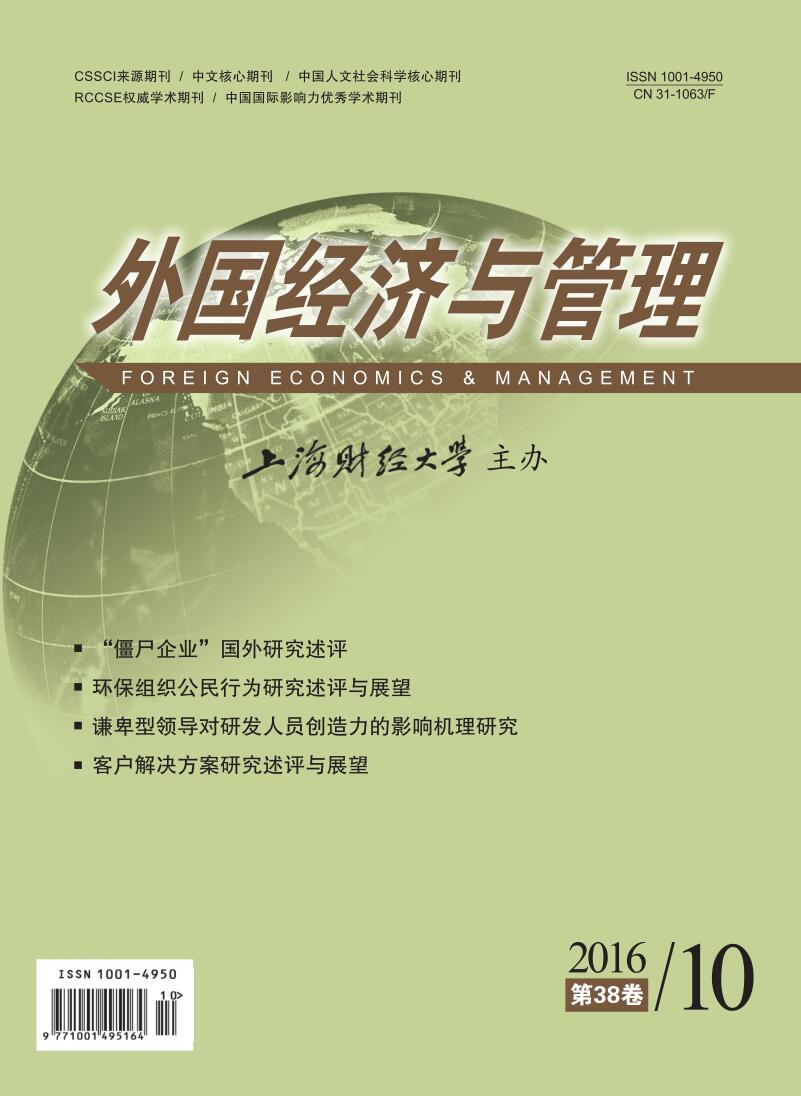资源冗余一直是资源基础理论、委托代理理论等关注的焦点。在过去的30年中,有关资源冗余的研究取得了大量的成果。在对资源冗余相关文献系统梳理的基础上,本研究剖析了资源冗余的内涵、分类结构与测量方法,围绕外部环境、风险倾向、组织以往绩效、组织规模与年龄等探究了资源冗余的影响因素,重点阐释了资源冗余与企业经济绩效之间的机制,包括技术创新、社会责任以及多元化战略的中介作用,行业动态性、风险资本等的调节作用。本研究为组织资源冗余研究提供了新的思路,丰富了资源基础理论,也为组织合理配置资源提供了有益的借鉴。
组织资源冗余:概念、测量、成因与作用
摘要
参考文献
9 Atuahene-Gima K. Resolving the capability-rigidity paradox in new product innovation[J]. Journal of Marketing, 2005, 69(4):61-83. DOI:10.1509/jmkg.2005.69.4.61
11 Bradley S W, Shepherd D A, Wiklund J. The importance of slack for new organizations facing 'tough' environments[J]. Journal of Management Studies, 2011, 48(5):1071-1097. DOI:10.1111/joms.2011.48.issue-5
12 Breton-Miller L, Miller D. The arts and family business:Linking family business resources and performance to industry characteristics[J]. Entrepreneurship Theory and Practice, 2015, 39(6):1349-1370. DOI:10.1111/etap.12177
13 Bromiley P. Testing a causal model of corporate risk taking and performance[J]. Academy of Management Journal, 1991, 34(1):37-59. DOI:10.2307/256301
14 Cheng J L C, Kesner I F. Organizational slack and response to environmental shifts:The impact of resource allocation patterns[J]. Journal of Management, 1997, 23(1):1-18. DOI:10.1177/014920639702300101
15 Cyert R M, March J G. A behavioral theory of the firm[M]. Englewood Cliffs, NJ:Prentice-Hall, Inc., 1963.
16 Davis G F, Stout S K. Organization theory and the market for corporate control:A dynamic analysis of the characteristics of large takeover targets, 1980-1990[J]. Administrative Science Quarterly, 1992, 37(4):605-633. DOI:10.2307/2393474
19 Geoffrey Love E, Nohria N. Reducing slack:The performance consequences of downsizing by large industrial firms, 1977-93[J]. Strategic Management Journal, 2005, 26(12):1087-1108. DOI:10.1002/(ISSN)1097-0266
20 George G. Slack resources and the performance of privately held firms[J]. Academy of Management Journal, 2005, 48(4):661-676. DOI:10.5465/AMJ.2005.17843944
21 Greenley G E, Oktemgil M. A comparison of slack resources in high and low performing British companies[J]. Journal of Management Studies, 1998, 35(3):377-398. DOI:10.1111/joms.1998.35.issue-3
22 Hendricks K B, Singhal V R, Zhang R R. The effect of operational slack, diversification, and vertical relatedness on the stock market reaction to supply chain disruptions[J]. Journal of Operations Management, 2009, 27(3):233-246. DOI:10.1016/j.jom.2008.09.001
25 Kang C, Germann F, Grewal R. Washing away your sins? Corporate social responsibility, corporate social irresponsibility, and firm performance[J]. Journal of Marketing, 2016, 80(2):59-79. DOI:10.1509/jm.15.0324
26 Lecuona J R, Reitzig M. Knowledge worth having in "excess":The value of tacit and firm-specific human resource slack[J]. Strategic Management Journal, 2014, 35(7):954-973. DOI:10.1002/smj.2014.35.issue-7
27 Leonidou C N, Katsikeas C S, Morgan N A. "Greening" the marketing mix:Do firms do it and does it pay off?[J]. Journal of the Academy of Marketing Science, 2013, 41(2):151-170. DOI:10.1007/s11747-012-0317-2
28 Levinthal D A, March J G. The myopia of learning[J]. Strategic management Journal, 1993, 14(S2):95-112. DOI:10.1002/(ISSN)1097-0266
29 Malen J. Motivating and enabling firm innovation effort:Integrating penrosian and behavioral theory perspectives on slack resources[J]. Hitotsubashi Journal of Commerce and Management, 2015, 49(1):37-54.
30 Miller K D, Leiblein M J. Corporate risk-return relations:Returns variability versus downside risk[J]. Academy of Management Journal, 1996, 39(1):91-122. DOI:10.2307/256632
31 Moreno A R, Fernandez L M M, Montes F J L. The moderating effect of slack resources on the relation between quality management and organisational learning[J]. International Journal of Production Research, 2009, 47(19):5501-5523. DOI:10.1080/00207540802014692
32 Mousa F T, Reed R. The impact of slack resources on high-tech IPOs[J]. Entrepreneurship Theory and Practice, 2013, 37(5):1123-1147. DOI:10.1111/etap.2013.37.issue-5
33 Nohria N, Gulati R. Is slack good or bad for innovation?[J]. Academy of Management Journal, 1996, 39(5):1245-1264. DOI:10.2307/256998
34 O'Brien J P. The capital structure implications of pursuing a strategy of innovation[J]. Strategic Management Journal, 2003, 24(5):415-431. DOI:10.1002/(ISSN)1097-0266
35 Richtnér A, Åhlström P, Goffin K. "Squeezing R & D":A study of organizational slack and knowledge creation in NPD, using the SECI model[J]. Journal of Product Innovation Management, 2014, 31(6):1268-1290. DOI:10.1111/jpim.12139
36 Sapienza H J, Autio E, George G, et al. A capabilities perspective on the effects of early internationalization on firm survival and growth[J]. Academy of Management Review, 2006, 31(4):914-933. DOI:10.5465/AMR.2006.22527465
38 Singh J V. Performance, slack, and risk taking in organizational decision making[J]. Academy of Management Journal, 1986, 29(3):562-585. DOI:10.2307/256224
39 Su Z F, Xie E, Wang D, et al. Entrepreneurial strategy making, resources, and firm performance:Evidence from China[J]. Small Business Economics, 2011, 36(2):235-247. DOI:10.1007/s11187-009-9211-9
40 Tan J, Peng M W. Organizational slack and firm performance during economic transitions:Two studies from an emerging economy[J]. Strategic Management Journal, 2003, 24(13):1249-1263. DOI:10.1002/(ISSN)1097-0266
42 Troilo G, De Luca L M, Atuahene-Gima K. More innovation with less? A strategic contingency view of slack resources, information search, and radical innovation[J]. Journal of Product Innovation Management, 2014, 31(2):259-277. DOI:10.1111/jpim.2014.31.issue-2
43 Vanacker T, Collewaert V, Paeleman I. The relationship between slack resources and the performance of entrepreneurial firms:The role of venture capital and angel investors[J]. Journal of Management Studies, 2013, 50(6):1070-1096. DOI:10.1111/joms.2013.50.issue-6
44 Voss G B, Sirdeshmukh D, Voss Z G. The effects of slack resources and environmental threat on product exploration and exploitation[J]. Academy of Management Journal, 2008, 51(1):147-164. DOI:10.5465/AMJ.2008.30767373
45 Wernerfelt B. A resource-based view of the firm[J]. Strategic Management Journal, 1984, 5(2):171-180. DOI:10.1002/(ISSN)1097-0266
引用本文
廖中举, 黄超, 姚春序. 组织资源冗余:概念、测量、成因与作用[J]. 外国经济与管理, 2016, 38(10): 49–59.
导出参考文献,格式为:
上一篇:环保组织公民行为研究述评与展望






 9795
9795  12147
12147

